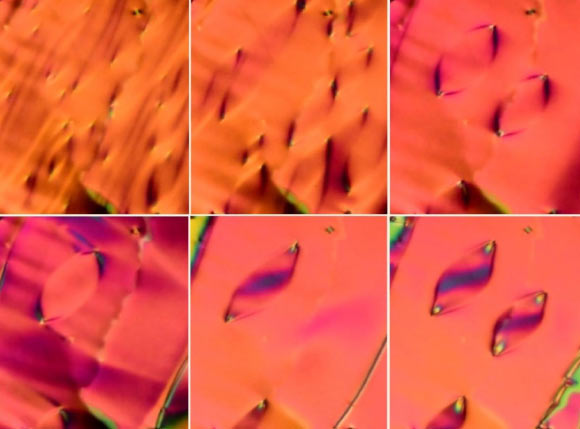A team of scientists from the University of Colorado Boulder and the University of Utah has confirmed the existence of a ferroelectric nematic phase of liquid crystal first proposed more than 100 years ago.
View of a new phase of liquid crystal as seen under the microscope. Image credit: Chen et al, doi: 10.1073/pnas.2002290117.
Nematic liquid crystals have been a hot topic in materials research since the 1970s. These materials exhibit a curious mix of fluid- and solid-like behaviors, which allow them to control light. Engineers have used them extensively to make the liquid crystal displays.
Think of nematic liquid crystals like dropping a handful of pins on a table. The pins in this case are rod-shaped molecules that are polar.
In a traditional nematic liquid crystal, half of the pins point left and the other half point right, with the direction chosen at random.
A ferroelectric nematic liquid crystal phase, however, is much more disciplined.
In such a liquid crystal, patches or domains form in the sample in which the molecules all point in the same direction, either right or left. In physics parlance, these materials have polar ordering.
“Our discovery of one such liquid crystal could open up a wealth of technological innovations — from new types of display screens to reimagined computer memory,” said University of Colorado Boulder’s Professor Noel Clark.
Nobel Laureates Peter Debye and Max Born first suggested in the 1910s that, if you designed a liquid crystal correctly, its molecules could spontaneously fall into a polar ordered state.
Not long after that, researchers began to discover solid crystals that did something similar: their molecules pointed in uniform directions. They could also be reversed, flipping from right to left or vice versa under an applied electric field. These solid crystals were called ferroelectrics.
Professor Clark and colleagues discovered that the liquid crystal phase of 4-[(4-nitrophenoxy)carbonyl]phenyl2,4-dimethoxybenzoate (RM734), an organic molecule created by University of York scientists in 2017, was 100 to 1,000 times more responsive to electric fields than the usual nematic liquid crystals.
This suggested that the molecules that make up the liquid crystal demonstrated strong polar order.
“When the molecules are all pointing to the left, and they all see a field that says, go right, the response is dramatic,” Professor Clark said.
The scientists also discovered that distinct domains seemed to form spontaneously in the liquid crystal when it cooled from higher temperature. There were, in other words, patches within their sample in which the molecules seemed to be aligned.
“That confirmed that this phase was, indeed, a ferroelectric nematic fluid,” Professor Clark said.
That alignment was also more uniform than the team was expecting.
“Entropy reigns in a fluid. Everything is wiggling around, so we expected a lot of disorder,” said University of Colorado Boulder’s Joe MacLennan.
“When we examined how well aligned the molecules were inside a single domain, we were stunned by the result. The molecules were nearly all pointing in the same direction.”
The study was published in the Proceedings of the National Academy of Sciences.
_____
Xi Chen et al. First-principles experimental demonstration of ferroelectricity in a thermotropic nematic liquid crystal: Polar domains and striking electro-optics. PNAS, published online June 10, 2020; doi: 10.1073/pnas.2002290117
This article is based on text provided by the University of Colorado at Boulder.

